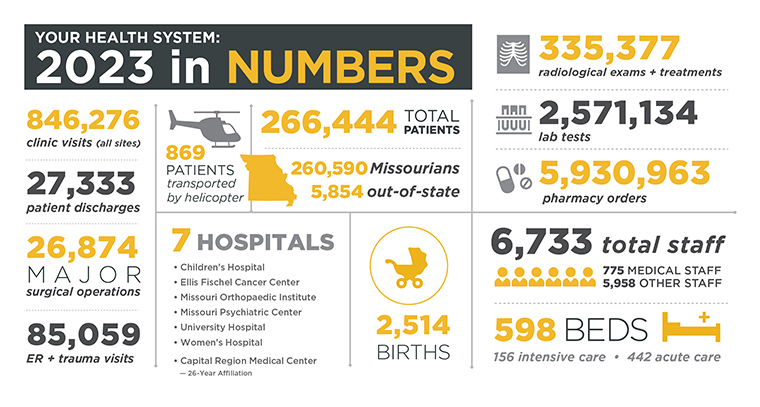Learn about the Emergency Medicine Residency Program.
What changes are happening with the residency?
In August of 2021, our faculty and staff began staffing the Emergency Department at Capital Region Medical Center in Jefferson City, MO. This has been a great experience for everyone and adds an aspect of rural-community medicine to our academic program. As of July 2022, based on positive feedback from our own residents, we have increased resident coverage there to a single daytime shift seven days per week given the educational value that Capital Region provides.
Additionally, MU Health Care has begun construction on a brand new, state of the art, Children's Hospital. While we await completion of that project in 2024, pediatric patients are currently seen in a designated pediatric-only area within the ED at University Hospital. The area is staffed with pediatric EM nurses and has its own separate entrance for pediatric patients and their families.
What is the resident salary?
PGY-1 $60,658. PGY-2 $63,178. PGY-3 $65,414. Residents and fellows are provided various plans from which to choose for medical, dental, vision, prescription, and life insurances, with optional coverages including disability, accidental death and dismemberment, and family coverage. Detailed benefit information can be found at Salaries and Benefits.
What are work hours like?
Residents work a combination of 8, 9, and 10-hour shifts. Shifts are designed with 1 hour of overlap to allow residents to complete charting and patient care while the next team begins seeing all new patients. Night shifts are always 8-hour shifts. Residents work 16-20 shifts per 28-day block in the ED.
How many vacation days will I have?
Residents receive four 1-week vacation periods per year. Vacation always occurs during an ED block except for one week of vacation during an elective month in the PGY-3 year.
What departmental benefits do I receive?
All residents receive free access to ROSH question bank and a number of the latest textbooks through Clinical Key, an EM: RAP subscription, and covered travel expenses to SAEM and ACEP national conferences. In addition to the above, PGY-1s receive free access to HIPPO EM videos.
What is the Curriculum like?
We take pride in providing an innovative non-clinical curriculum in addition to our robust clinical rotations. Each week we have 5 hours of dedicated conference time with topics spanning the entire breadth of EM. The curriculum spans 18 months and is weighted based on clinical relevance, so residents are well prepared for any practice setting. Behind this, we have a team of dedicated faculty to ensure each resident has the resources they need to become a successful and well-rounded emergency medicine physician. For additional information, please see our Curriculum section.
What other clinical sites are there?
Residents rotate at University Hospital, which includes our new Children's Emergency Department, as well as Capital Region Medical Center in Jefferson City, Missouri. Some residents choose to do an elective at Moberly Regional Medical Center to experience community emergency medicine.
Tell me about UMC

Additional information can be found here Facts/Figures.
What do you do for Resident Wellness?
Wellness is integrated into the program from July of PGY-1 year to graduation. Regularly scheduled events such as the yearly float trip and the post-training exam dinner are perennial favorites. We establish faculty mentors in the PGY-1 year who then provide continued support and feedback. Residents have a voice through the recurring 'Residency Round Table,' where ideas can be shared and concerns addressed. Our internal website provides access to wellness and mental health resources, our maternity/paternity leave policy, as well as financial planning resources.
How is your program focusing on Diversity and Inclusion?
Our program is aligned with the University of Missouri School of Medicine Office of Diversity and Inclusion in pursuing a diverse and qualified community. We have recently registered for the LMSA (Latino Medical Student Association) National Mentor Registry. We are working with our school’s SNMA chapter (Student National Medical Association). We are participating in the SAEM/RAMS and AAEM/RSA “Diversity Regional Meet-N-Greet” webinar, and our Program Director and Associate Program Director are registered for ACEP/EMRA Diversity Mentoring Initiative. D&I is a new focal point for our program and we are committed to fostering its growth.
What is life like in Columbia?
Columbia has something to offer for everyone. Columbia Parks and Recreation maintains over 3,000 acres of parkland spanning 80 different parks and recreation facilities in addition to over 50 miles of trails. The city welcomes a multitude of festivals each year, including Art in the Park, Boone County Fair, Roots N Blues, the Show-Me State Games, and the world-renowned True/False Film Fest. There are also year-round sports programs to provide recreational opportunities in addition to Columbia being home of the Mizzou Tigers. Visit the Columbia Convention and Visitors Bureau website for more detailed information.
What is Interview Day like?
Interview days are Wednesdays from November through January. All interviews are virtual. Applicants will either be in the AM group or the PM group and will also have the opportunity to participate in various meet and greets with our current residents to allow time for candid questions and conversation. Typically, you will interview with the PD, an APD, a Chief Resident, and a faculty member.
Is Moonlighting allowed?
We allow internal and external moonlighting for PG2 and PG3 residents who meet certain criteria. The majority of our residents participate in some form of moonlighting.
How is Pediatrics done?
Pediatrics begins with a dedicated block of Pediatric EM in the PGY-1 year, which then transitions to a longitudinal integration of shifts for the remaining PGY-2 and PGY-3 years. The vast majority of our pediatric education occurs with our full-time, board-certified Pediatric Emergency Medicine faculty.
Who manages the airway?
Emergency medicine faculty handle all airways at all times in all patients. EM faculty control and manage the airway until the patients leave the Emergency Department.
How do traumas run?
Trauma alerts are divided into levels I, II, and III. PGY-2 and PGY-3 EM residents manage Level I and II cases in the resuscitation bay in conjunction with the trauma team. The EM resident always performs any required intubations. Performance of chest tubes and FAST exams alternates between EM and Trauma every other day.





